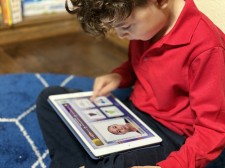Innovative Listening Training for Autism Has Transformative Potential

DALLAS, February 11, 2020 (Newswire.com) - Smarty Ears receives an SBIR Phase 1 Award from the National Institute of Health (NIH) to develop a technology that will attempt to reduce the difficulty some children have with understanding speech in noisy conditions. The purpose of this Small Business Innovation Research (SBIR) grant is to develop an innovative adaptive listening training system in the form of an iPad app and to gather preliminary data to validate the usability and efficacy of the app.
Listening in noise is a seamless activity that typically developing children do, and it is vital to communication and academic success. However, children with developmental disabilities, such as autism (ASD) and hearing loss, have difficulty with understanding speech in noise. Irwin and Brancazio (2014) recently reported that children with ASD look less overall at speaking faces and less to the mouth of the speaker compared to typically developing children in the context of auditory noise.
A team led by veteran app innovator, speech-language pathologist, and Smarty Ears CEO Barbara Fernandes, M.S. CCC-SLP, has managed to translate previous preliminary research of this grant’s co-investigators, Dr. Sullivan and Dr. Irwin in order to develop a fully functioning gamified prototype of Listening 2 Faces.
“Creating an app such as Listening 2 Faces was very challenging due to the nature of the auditory tasks. It takes an enormous amount of effort, but the result is nothing short of phenomenal. The app has innovative technology that has the potential to be transformative for children who normally have to listen to speech in noisy conditions at school, playgrounds, restaurants and everyday interactions,” said Mrs. Fernandes.
Listening 2 Faces is the first automated training program for individuals with communication disorders using audiovisual speech. Dr. Irwin’s work has shown in a small-scale efficacy study that the specific training task implemented in L2F product generalizes to improve identification of speech in auditory-only testing conditions with a novel speaker (Irwin et al., 2014), indicating that training will provide real-world benefits for children with ASD and other communication disorders.
L2F uses adaptive achievement milestones that automatically adjust the difficulty level of the training task to maintain a constant level of challenge for the child. Many studies have shown that protocols maintaining accuracy in the 75-85% range are optimal for learning.
Critically, Smarty Ears has embedded the training in a “game-like” program meant to appeal to children. This training system will gradually scaffold children’s perceptions of speech by training in increasingly more challenging noise levels. Mrs.Fernandes has developed a library of over 1,000 high-definition videos with speakers that are diverse in age, gender and ethnicity who produce the words children are asked to identify in order to simulate real-life interactions.
Smarty Ears is currently recruiting participants for the Listening 2 Faces clinical trials in Connecticut, Texas and Virginia. Smarty Ears is also recruiting participants for pre-launch interviews which aims to collect feedback and gather market analysis about the potential commercialization of Listening 2 Faces as part of its participation on the i-Corps program also funded by the NIH. For more information please contact the Smarty Ears team at contact@smartyearsapps.com
Research reported in this press release was supported by National Institute on Deafness and Other Communication Disorders (NIDCD) of the National Institutes of Health under award number 1R43DC017405-01A1. The content is solely the responsibility of the authors and does not necessarily represent the official views of the National Institutes of Health.
Source: Smarty Ears
